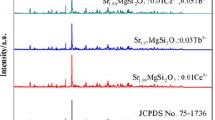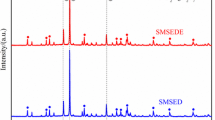Abstract
The micron-sized Sr2(P2O7):Ce,Tb green phosphors were prepared by being annealed at different temperatures with its precursors synthesized by co-precipitates of (NH4)2HPO4 at ambient temperature. The phase structure, grain size, surface morphology, and luminescent properties of phosphors were investigated by X-ray diffraction, scanning electron microscope, transmission electron microscope, and fluorescence spectrum. The results show that the product of precursor annealed at 1,100 °C is Sr2(P2O7):Ce,Tb, which belongs to orthorhombic phase. The powder is spherical and the size distribution is in micron grade. The sample with the molar ratio of Sr/Tb/Ce of 100.0:0.4:0.6 shows the best fluorescence effect annealed at 1,100 °C for 3 h. The phosphors produce green fluorescence by being excitated with ultraviolet radiation of 254 nm wavelength, and the main emission peak is at 547 nm. The Sr2(P2O7):Ce,Tb phosphors synthesized by co-precipitation method of precursors at ambient temperature is a kind of efficient green-emitting phosphors.
Similar content being viewed by others
Avoid common mistakes on your manuscript.
1 Introduction
Fluorescent lamp possesses outstanding features for its good fluorescence efficiency with high light intensity, saving energy, long life time, low heat productivity, and is the most widely used in daily life for the common people [1–4]. The key component of fluorescent lamp is the luminescent materials, which has the important influence on the light intensity of fluorescent lamp [5–7]. The phosphate phosphors have a long history of development in luminescent materials. It is easily synthesized with low cost raw material and exhibits high fluorescence performance, so it is applied in fluorescent lamp with these advantages [8, 9]. In recent years, special attention has been drawn on the synthesis and potential applications of certain luminescent phosphor materials doped with rare earth ions sensitizing agent to form active centers [10–13]. Structural details and processes involving in the excitation multiplication for some 4f–4f and 5d–4f transitions of doped optical systems were investigated [14, 15]. The main methods to prepare the luminescent materials are high temperature solid state, sol–gel, combustion, hydrothermal, and co-precipitation, etc. The industrial production of luminescent materials is high temperature solid phase method; however, it is highly energy-consuming due to the high reaction temperature and long reacting time. The co-precipitation does not have these shortcomings, which is the most economical method. In this paper, the micron-sized Sr2(P2O7):Ce,Tb green phosphors were prepared by being annealed at different temperatures with its precursors synthesized by co-precipitates of (NH4)2HPO4 at ambient temperature. The phase structure, size, morphology, and luminescent properties of phosphors were investigated.
2 Experimental
In a typical synthesis process, Ce(NO3)3 and Tb(NO3)3 was added to the solution of Sr(NO3)2 to make a mixed solution with the concentration of 0.5 mol·L−1. The molar ratio of Sr(NO3)2/Ce(NO3)3 and Tb(NO3)3 is 100:1, and the molar ratio of Ce(NO3)3/Tb(NO3)3 are 1:1, 2:3, or 3:2, respectively. The transparent precursor solution was magnetically stirred for 5 h at room temperature. The solution of (NH4)2HPO4 was slowly added into the former solution with the vigorous stirring, and then the transparent precursor solution became turbid. The solution of NH3·H2O was slowly added in vigorous stirring to adjust pH value to 7. After being aged at room temperature for about 2 h, the white precipitate was separated by centrifuging and washing several times with de-ionized water. After drying the samples at room temperature, they were annealed at different temperatures of 900, 1000, 1100, and 1200 °C in weak reducing atmospheres for 2, 3, and 4 h, respectively.
The product phase was identified by X-ray diffraction (XRD, Model D/max-2200PC, Rigaku, Tokyo, Japan) using Cu Kα radiation. A FEI Sirion200 scanning electron microscope (SEM) was used for morphological analysis of the samples. The photoluminescence spectra of the powder phosphor were measured by a fluorescence spectrophotometer (Model RF-5301, Shimadzu, Japan) at room temperature.
3 Results and discussion
3.1 Phase characterization
Figure 1 shows the XRD pattern of the synthesized Sr2(P2O7):Ce,Tb (molar ratio of Ce/Tb = 2:3) sample. The XRD pattern agrees well with JCPDF 12-362, which shows the product is a single phase of Sr2(P2O7) and belongs to orthorhombic crystal system. The sharp diffraction peaks imply that the particles are highly crystalline. The lattice parameters calculated from the XRD measurement are a = 89.10 nm, b = 54.04 nm, and c = 131.00 nm.
3.2 SEM characterization
Figure 2 shows the SEM images of the Sr2(P2O7):Ce,Tb (molar ratio of Ce/Tb = 2:3) powder phosphor by annealed at different temperatures. The powder consists of spherical crystals with a uniform size of 2 μm in length annealed at 900 and 1,000 °C. Spherical crystals have a uniform size of 3–4 μm in length annealed at 1,100 °C, but the shape of crystals changes and grain sizes increase obviously annealed at 1,200 °C. At high temperature, overburning may occur and leads to liquefy the crystals and recrystallize.
3.3 Fluorescence performance
Figure 3 presents the excitation spectrum of Sr2(P2O7):Ce,Tb (molar ratio of Ce/Tb = 2:3) phosphor annealed at 1,100°C with an excitation band at 254 nm. The emission bands of 486, 542, 584, and 625 nm are attributed to 5D4 → 7F6, 5D4 → 7F5, 5D4 → 7F4, 5D4 → 7F3 of transition of 4d5 level of Tb3+, respectively. The energy level transition of 5D4 → 7F6 leads to energy level splitting, which is attributed to outermost electrons of Tb3+ being influenced by the crystalline field shown in Fig. 3. The emission band of Ce3+ does not appear, because that Ce3+ undertake the sensitization, which can enhance the luminescent intensity of Tb3+.
Figure 4 presents the excitation spectrum of Sr2(P2O7):Ce,Tb (molar ratio of Ce/Tb = 2:3) phosphor annealed at different temperatures (between 900 and 1,200 °C) for 4 h with an excitation band at 254 nm. From Fig. 4, we find that the sample prepared at 1,100 °C exists the maximum green emission intensity. Fluorescence intensity of samples improves with annealed temperature in the sintering temperature range. But overburning can lead to the crack of crystal lattice, liquefy the crystalline phase and the imperfection escalation on the high temperature, which result in decreased fluorescent strength.
The excitation spectra were measured with the samples annealed for different time (2, 3, and 4 h, respectively). Figure 5 presents the excitation spectrum of Sr2(P2O7):Ce,Tb (molar ratio of Ce/Tb = 2:3) phosphor prepared at 1,100 °C for different time. According to Fig. 5, luminous intensity increases with the increase of annealing time. The luminous performance can be influenced by the crystalline degree of sample. At high annealing temperature, the crystalline degree enhances with the annealed time.
Figure 6 presents the excitation spectrum of Sr2(P2O7):Ce,Tb phosphor at different doping molar ratios of Ce/Tb. From Fig. 6, the relative fluorescence intensity increases with the Tb3+ doping content. It can be concluded that more doping content of Tb3+ can increase the fluorescence performance.
3.4 Chromaticity coordinates
Figure 7 shows the commission international del’eclairage (CIE) chromaticity coordinates of the Sr2(P2O7):Ce,Tb phosphor (molar ratio of Ce/Tb = 2:3). The chromaticity coordinates of the phosphor are x = 0.253 and y = 0.588. In the PL spectra, Sr2(P2O7):Ce,Tb phosphor exists a strong green emission with the UV light excitation (254 nm) at 7,114 K. It means the Sr2(P2O7):Ce,Tb phosphor could be a good green phosphor candidate for creating white light in phosphor-converted white light.
4 Conclusion
Sr2(P2O7):Ce,Tb phosphors were prepared with co-precipitation method. The product is a single orthorhombic phase of Sr2(P2O7) and free of secondary phases. The powders are spherical and the size distribution is micron grade. The phosphors produce green fluoresce when excitated by ultraviolet radiation of 254 nm wavelength. The emission peak is at 547 nm. Sr2(P2O7):Ce,Tb phosphors synthesized by co-precipitation method of precursors at ambient temperature is an efficient green-emitting fluorescer.
References
Dong Y, Wu ZS, Chen R, Gu WJ, Han XL. Synthesis of BaMgAl10O17:Eu2+ phosphor via co-precipitation method and its synthesis mechanism. J Chin Ceram Soc. 2011;39(8):1229.
Wang J, Wang SB, Su Q. Luminescence and defect properties of novel bluish-green phosphor β-Zn3(PO4)2:Zr4+. J Rare Earths. 2004;22(1):83.
Song F, Ming CG, An LQ, Wang QR, Yu Y, Yu H, Sun QT, Tian JG. Tm3+/Tb3+/Mn2+ tri-doped phosphate glass ceramic for enhanced white-light-emitting material. Mater Lett. 2011;65(19–20):3140.
Rao KV, Ratnakaram YC, Seshadri M, Rao JL. Optical and luminescence studies of Pr3+ and Er3+ doped different phosphate glasses. Physica B. 2010;405(9):2297.
Ratnakaram YC, Srihari NV, Naidu DT, Vijayakumar A, Chakradhar RPS. Spectroscopic investigations on Ho3+ doped mixed alkali phosphate glasses. Opt Mater. 2008;30(10):1635.
Huang YW, Xiao B. Research and application prospect of rare-earth luminescent materials. Conserv Util Miner Resour. 2008;6:51.
Khimich NN, Berdichevskii GM, Poddenezhnyi EN, Golubkov VV, Boiko AA, Ken’Ko VM, Evreinov OB, Koptelova LA. Sol–gel synthesis of an optical silica glass doped with rare-earth elements. Glass Phys Chem. 2007;33(2):152.
Mukherjee S, Dutta DP, Manoj N, Tyagi AK. Rare earth doped hydrated and anhydrous zinc phosphate nanophosphors: a promising white light emitter. J Lumin. 2013;134:880.
Li XL, Zhang ZY. Development of rare earth luminescent materials in energy in the field of lighting. Chin Rare Earths. 2008;29(2):69.
Meiser F, Cortez C, Caruso F. Biofunctionalization of fluorescent rare-earth-doped lanthanum phosphate colloidal nanoparticles. Angew Chem Int Ed Engl. 2004;43(44):5954.
Goldner P, Schaude B, Prassas M, Auzel F. Influence of the host structure and doping precursors on rare earth clustering in phosphate glasses analysed by cooperative luminescence. J Lumin. 2000;87–89:688.
Nandi P, Srinivasan A, Jose G. Structural dependent thermal and optical properties of rare earth doped glass with mixed glass formers. Opt Mater. 2009;31(4):653.
Zhao K, Luo XY, Cui XZ, Xia T, Yu ZJ, Zhao CL, He T, Zhuang WD. Present status and prospect of fluorescent dye used for CCFL. Chin J Rare Met. 2008;32(2):245.
Namila, Wang FM, Wang XG, Ao LG. Preparation and luminescent properties of ZnMoO4:Tb3+. Spectrosc Spectr Anal. 2012;32(10):2605.
Li Y, Wang YH, Xiong Y, Peng TQ, Zhao H. Effect of Sr/Ca ratio on structure and luminescence properties of phosphor Sr3−x Ca x Al2O6:Eu2+, Dy3+. Rare Met Mater Eng. 2013;42(2):349.
Acknowledgments
This project was financially supported by the National Natural Science Foundation of China (No. 21273060) and the Program for New Century Excellent Talents in Heilongjiang Provincial University (No.1251-NCET-014).
Author information
Authors and Affiliations
Corresponding author
Rights and permissions
About this article
Cite this article
Ma, CG., Zheng, W., Jin, LG. et al. Fluorescence and preparation of Sr2(P2O7):Ce,Tb phosphate by co-precipitation method. Rare Met. 32, 420–424 (2013). https://doi.org/10.1007/s12598-013-0113-2
Received:
Revised:
Accepted:
Published:
Issue Date:
DOI: https://doi.org/10.1007/s12598-013-0113-2











